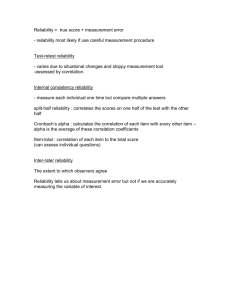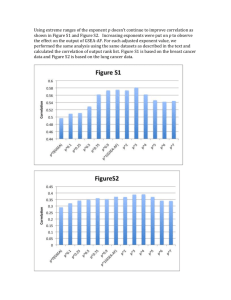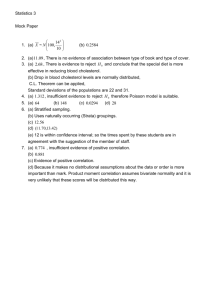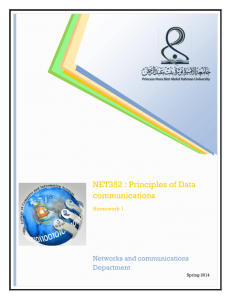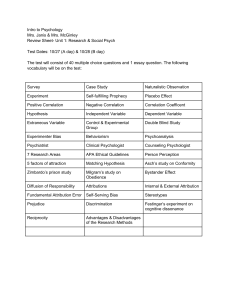Echography Using Correlation Techniques: Choice of Coding Signal
advertisement
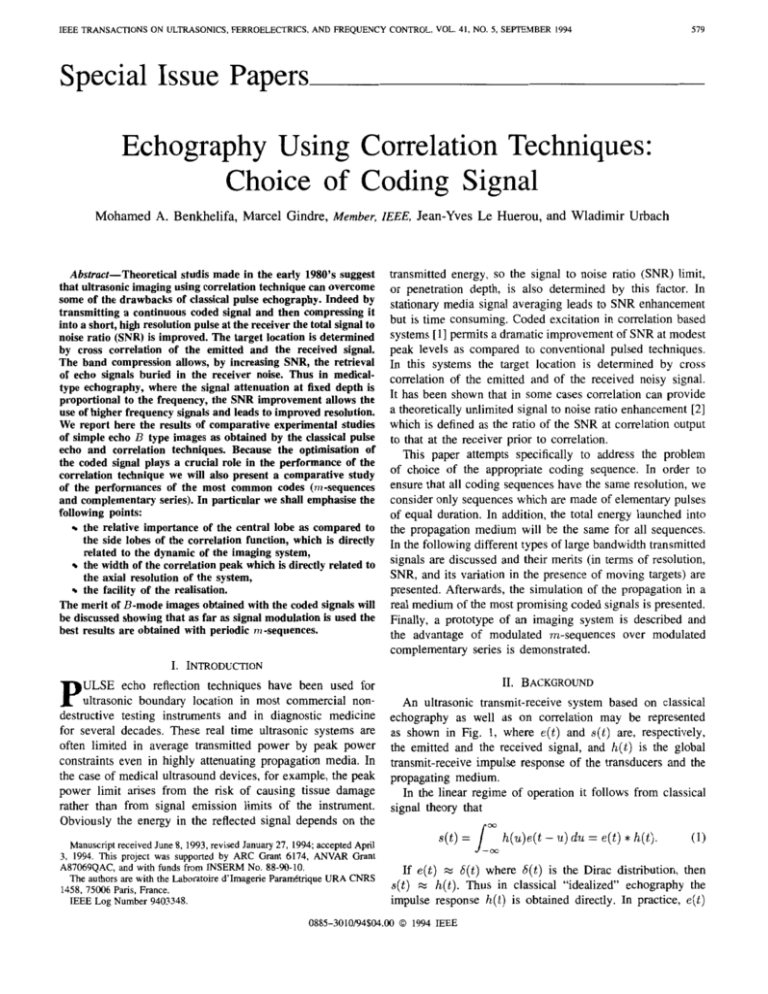
Special Issue Papers
Echography Using Correlation Techniques:
Choice of Coding Signal
Mohamed A. Benkhelifa, Marcel Gindre, Member, IEEE, Jean-Yves Le Huerou, and Wladimir Urbach
Abstract-Theoretical studis made in the early 1980’s suggest
that ultrasonic imaging usingcorrelation technique can overcome
some of the drawbacks of classical pulse echography. Indeed by
transmitting a continuous coded signal and then compressing it
into a short, high resolution pulseat the receiver the total signal to
noise ratio (SNR) is improved. The target location is determined
by cross correlation of the emitted andthe receivedsignal.
The band compression allows, by increasing SNR, the retrieval
of echosignals buried in the receiver noise. Thus in medicaltype echography, where the signal attenuation at fixed depth is
proportional to the frequency, the SNR improvement allows the
use of higher frequency signals and leads to improved resolution.
We report here the results of comparative experimental studies
of simple echo B type images as obtained by the classical pulse
echo and correlation techniques.Because the optimisation of
the coded signal plays a crucial role in the performance of the
correlation technique wewill also present a comparative study
of the performances of the mostcommoncodes(m-sequences
and complementary series). In particular we shall emphasise the
followingpoints:
the relative importance of the central lobe as compared to
the side lobes of the correlation function, which is directly
related to the dynamic of the imaging system,
the width of the correlation peak which is directly related to
the axial resolution of the system,
the facility of the realisation.
The merit of B-mode images obtained with the coded signals will
be discussed showing that as far as signal modulation is used the
best results are obtained with periodic m-sequences.
transmitted energy, so the signal to noiseratio(SNR)limit,
orpenetrationdepth,isalsodetermined
by thisfactor. In
stationary media signal averaging leads to SNR enhancement
but is time consuming. Coded excitation in correlation based
systems [ l ] permits a dramatic improvement
of SNR at modest
peaklevelsascompared
to conventional pulsed techniques.
In this systems the targetlocation is determined by cross
correlation of the emitted and of the received noisy signal.
It has been shown that in some cases correlation can provide
a theoretically unlimited signal to noise ratio enhancement [2]
which is defined as the ratio of the SNR at correlation output
to that at the receiver prior to correlation.
Thispaperattempts
specifically to addresstheproblem
of choice of theappropriatecodingsequence.
In order to
ensure that all coding sequences have the same resolution, we
consider only sequences which are madeof elementary pulses
of equal duration. In addition, the total energy launched into
the propagation medium willbe the same for all sequences.
In the following different typesof large bandwidth transmitted
signals are discussed and their merits (in terms of resolution,
SNR, and its variation in the presence of moving targets) are
presented. Afterwards, the simulation of the propagation in a
real medium of the most promising coded signalsis presented.
Finally, a prototype of an imaging system is described and
theadvantage of modulatedm-sequencesovermodulated
complementary series is demonstrated.
I.INTRODUCTION
P
ULSE echo reflection techniqueshavebeen
used for
ultrasonicboundarylocation
in mostcommercialnondestructivetestinginstrumentsand
in diagnosticmedicine
forseveraldecades.These
real time ultrasonicsystemsare
oftenlimited in averagetransmittedpower by peakpower
constraints even in highly attenuating propagation media. In
the case of medical ultrasound devices, for example, the peak
powerlimitarisesfromthe
risk of causingtissuedamage
rather than fromsignalemissionlimits
of theinstrument.
Obviously the energy in the reflected signal depends on the
Manuscript received June 8, 1993, revised January 27, 1994; accepted April
3,1994. This projectwas supported by ARC Grant6174, ANVAR Grant
A87069QAC. and with funds from INSERM No. 88-90-10,
The authors are with the Laboratoire d’ImagerieParamktrique URA CNRS
1458, 75006 Paris, France.
IEEE Log Number 9403348.
11. BACKGROUND
An ultrasonictransmit-receivesystem based onclassical
echography as well ason correlation may be represented
as shown in Fig. 1, where e ( t ) and s ( t ) are,respectively,
theemittedand the receivedsignal,and h ( t ) istheglobal
transmit-receive impulse response of the transducers and the
propagatingmedium.
In the linear regime of operation it follows from classical
signal theory that
W
s(t) =
h(u)e(t- U ) du = e ( t ) * h ( t ) .
S_,
(1)
If e ( t ) z 6 ( t ) where 6 ( t ) is theDiracdistribution,then
s ( t ) z h@).Thus inclassical“idealized”echography
impulseresponse h ( t ) isobtaineddirectly.
0885-3010/94$04.00 0 1994IEEE
the
In practice, e ( t )
IEEE TRANSACTIONS ON ULTRASONICS. FERROELECTRICS. AND FREQUENCY CONTROL, VOL. 41, NO. 5 , SEPTEMBER 1994
580
(b)
Fig. I . Schematicblockdiagram
of the
ultrasonicimaging
Classical system. (b) System using correlationtechniques.
system. (a)
is a high voltage pulse. Its duration is short in order to fully
exploit the bandwidth of the transducer and to maximise the
resolution.
There is asecondmethodforevaluating
h ( t ) [3]. In
correlation based systems the output is
L
ree(t)
03
~ ( t=)
s ( E ) e ( E - t )4 = r e e ( t )
* h(t)
(2)
where
is the autocorrelationfunction of theemitted
signal e ( t ) .
If e ( t ) is such that ree(t)
M 6 ( t ) , we have r ( t ) M h(t). In
other words, this means that ifwe choose an emitting signal
such that its autoconelation function is a Dirac distribution,
the impulseresponse of the system isgiven by the crosscorrelation function between emission and reception.
Only white noise gives an autocorrelation function which
isequivalent to aDiracdistribution.Severalothertypes
of
transmitted signals have been proposed by different authors.
These include wide-band m -sequences [4]-[6], random noise
[l], chirp [7]-[9], Golay codes [lo], [ l l], Barker code [12].
The autocorrelation functionsof such signals consistof a main
peak and secondary maxima. The higher the value of the ratio
of mainpeakamplitude (LP)to the highest secondary lobe
amplitude ( L s ) , thecloser will be the shape of reeto the
Dirac function. For chirp codes Lp/Ls is only equal to 13 dB.
In order to improve this value a very efficient apodization is
necessary which leads to a broadening
of Fee and thus to a
significant decrease of axial resolution [13]. It has been shown
recently that by using an adapted signal processing theLp/Ls
ratio can reach 40 dB [9]. In the next section we shall briefly
review discrete codes which fit the best to our purpose.
111. EVALUATION
OF CODED SIGNALS
A variety of codesareavailableforapplication
in the
system.Factorsaffecting
the choice of codeare:ease
in
generation:peak to sideloberatio
( L p / L s ) in thecorrelation function, and the processing complexity. With a microcomputer system, generation of any code can easily be done
by writing the appropriatedatato
the transmission buffer
in the code generation unit. Software processing for various
codes is straightforward. Thus the main criterion is the value
of peak to sideloberatio ( L p l L s ) . In ordertoallow easy
comparison between the most common codes we will present
hereafter a comparative study basedon the following protocol.
1 ) For each code the numberandor the amplitudeof its binary
elements can vary. However thetotal energy launched into the
propagating medium is the same for all codes considered. For
a fixed amplitude of any code this requires that the product
of theemission time andthesquare
of theamplitude be
constant. 2) In order to make the axial resolution of all codes
equivalent, the duration of each binary element of any code
was fixed at the same value r . 3) All simulations were made
with sampledsignals.Foranycode
the number of samples
per binary element was 16. 4) In the correlation system the
returning wave form from a moving target no longer matches
the reference signal.In order to determine the mismatch effects
weshallconsider the variation of Lp/Ls with the Doppler
shift frequency.
Let
c
N
ernod(t) =
Unnn(t)
exp [i(wOt f (P,)]
(3)
n=l
be the general expression of the modulated and coded signal
where a, istheamplitude
of the nth binary element of
duration r , and (
p
,
isthecorrespondingphase,
N isthe
number of binary elements ( N T = 7') and
nn(t)=
{ 01
for (n - 1)' 5 t 5 nn7
elsewhere
We shall consider three different types of code:
A : a, = l a n d p , = O o r r
B : a, = 1 and (
p
variable
,
C : a, and (
p
variable.
,
For codes of type A the autocorrelation function is given
for the periodic case by:
N
m=l
with k 2 0 and j = ( m
case, andby:
+ k) modulo N , and for nonperiodic
A'- k
m=l
with IC 2 0 and j = m + k . For codes of types B or C we have
calculated the autocorrelation function following the method
suggested by Bernfeld and Liebman [14].
A-Type Codes
For Barker's codes [l51 the ratio (Lp/Ls),,,
is about 22
dB. This result can be improved by combined Barker's codes
[ 161, [l71 but it is limited to a value of 30 dB. For our purpose
them-sequence and complementaryGolaycodesarebetter
candidates.
BENKHELIFA er 01.: ECHOGRAPHY USING CORRELATIONTECHNIQUES
58 1
IV. MOVINGTARGETEFFECTS
Maximal Length Sequence: The m-sequence [ 181, simpler
to implement, is a perfectly deterministic sequence of N =
In case of a multifrequency broadband waveform,the effect
(271, - 1) binary digitswhichdisplays
a certainnumber of of a moving target can be describedasa
modification of
properties of randomness approximating those of white noise. theduration of the waveform which isproportional to the
It is often referred to as a pseudorandom binary sequence or target velocity. In classical echographic techniques the result
pseudonoise. In thecase of nonperiodicemission ofan N is alonger or shorterburst.
In a correlationsystem
the
element sequence [19], the peak to side lobe ratio L p / L s 5 motion of the target will produce a cross-correlation function
20 log v%. The ratio L p / L s = 20 log N is equal to 42 dB for which will not align as required foroptimumcancellation
N = 127 when the m-sequence is transmitted continuously. of laterallobes.ThustheDopplershiftshouldproduce
a
This precludes however the use of a single transducer, which significantdegradation of the peak to sideloberatio mainly
is not the case with Golay’s codes.
due to an increase in amplitude of the laterallobes.
To
Golay’s Codes: Golay’s codes are pairs of complementary determine the effects of the mismatch of wide-band signals,
binary codes [20]. The autocorrelation functionof each codein one can analyze the form of the ambiguity function [3], [30].
a pair has a central peak and a range of side lobes of identical ~ ( 0w ,d ) = a * ( t ) a ( t- 0) exp ( i w d t ) dt. Where wd = 2 ~ f , l
shape but of opposite sign. The additionof the autocorrelation is the pulsation shift produced by the Doppler effect. When
functions from apair of complementary codes produces a large W d = 0, ~ ( 0 is
) simply theautocorrelationfunction of the
triangularcentralpeak
with nosidelobes
( L p / L s -+ m). complexenvelop a ( t ) of the emittedsignal e ( t ) . Using the
The length of Golay’s code usable by any correlation system expression for x,the modulus of the ambiguity functions were
is only limited by thegenerationcapability of thesystem.
then plottedfor 7n-sequences andGolaycodes [31]. The x
Othercodeshave
also been shown to have thesamezero
functions were defined in terms of the delay (7 axis)and a
rangesidelobeproperty
[21]-[23]. It is worth noting that dimensionless parameter T . fd where T is the duration of the
because Golay’s codes involve the sequential transmission of coded sequence and fd is the Doppler shift.
two related sequences, real time imaging of some systems is
Foraperiodicm-sequence
of 127 binary elementsthe
prohibited with this type of code.
ambiguity function is plotted in Fig. 2. For zero Doppler shift
(fd = O)Lp/Ls M 42 dB as expected. When fd increases, the
secondary lobes rise very rapidly, and the peak to side lobe
Type B codes were generated as suggested by Frank [24]. ratio reaches the value of 23 dB for T . fd = 0.2.
TheGolay’scodesareemitted
in aconsecutivemanner,
Consider a code of N elements. Let j and m be two indexes
and
it
is
probably
optimistic
to
assume
that the Doppler shift
with 0 5 j 5 0and 0 5 m 5 fi. The phase of each
is
exactly
the
same
for
both
sequences.
However, if this
element pJn = [27r/fi] ( j m). The N elements of code
hypothesis
is
correct,
the
resulting
ambiguity
function
x is
are thus emitted in fi subgroups. For each subgroup j is
shown
in
Fig.
3.
To
allow
better
readability
x
was
truncated
at
kept fitted while m runs from 0 to fl- 1. For sufficiently
-60
dB,
although
the
LplLs
value
for
fd
=
0
is
theoretically
high values of N one can show [25] that
infinite.Hereagain,
the amplitude of the secondarylobes
increases rapidly with fd, and for T .fd = 0.2, LpILs reaches
- = 2010g (7rJN).
25 dB,aslightlybettervalue
than in the case of the mLs
sequence. This requires two sequences
of 128 b each, however,
For L p / L s 50 dB, the phase is in units of 2 7 r / f i M 3.6”. doubling the energy launched into the medium.
Both codes are sensitive to Dopplershifts.However they
This is hard to implement when the operating frequency is of
the order of some Megahertz. That iswhy codes with only two can, in principle, easily provide a 50 dB peak to noise ratio.
Periodicm-sequencesareeasy
to generate, but because of
phase values are more practical and appear more attractive.
continuous emission the need to use separate transducers for
transmission and reception seemsto be one potential drawback
C-Type Codes
of the method.Golay’scodes
offer the advantage of side
Huffman has shown [26]-[28] that by varying the amplitude lobe cancellationand seem morepromising at this stage of
and the phase of each element of the coding sequence it is study where the propagating medium is absent. To understand
possible to increase significantly the peak to side lobe ratio.
in whatmanner the propagatingmedium can influence our
In spite of very promising results, however, implementationof results, we shall consider the propagation of Golay codes and
Huffman coding sequences remains very delicate. Kretschmer m-sequences through a simulated medium in the next part of
and Lin [29] have shown that an error of 5% in the form of thispaper.
each of 64 binary elements of a Huffman sequence induces
a loss of 20 dB in the peak to noiseratio.Suchsensitivity
makes it impractical to use.
V. SIMULATEDRESULTS
It isapparentfrompreviousdiscussion
that only mThem-sequencesandcomplementaryseries
were extensequenceandGolay’scodesprovide
sufficient SNR and
easy implementation to ultrasonicimaging. In the following sively used by several authors [ 5 ] , [ 1 l], [3 I], [32]. However,
we shall only consider this twotypes
of codes and the even if the theoretical improvement of the SNR is obvious, the
corresponding SNR degradation due to Doppler effects.
observed SNR is far from the theoretical prediction, especially
B-TypeCodes
+
(a)
4 x
(a)
-Doppler shift T.fd= 0
-Doppler shift T.fd = 0
~
Doppler shift T.fd= 0.2
I
- 6 0 ~ l [ t l r t l l t l 1 l 1 l1 , 1
-128
-96 -64
-32
0
'
1 1 I
, , I I I I I I I I I
32
64
Dopplershift
T.fd= 0.2
0
96
P
-140
b
128
-128
-96
-64
Delay (bit number)
(b)
-32
0
32
Delay (bit number)
61
96
128
(b)
Fig. 2. Ambiguity function for a 127 bit rn-sequence. (a)3-D representation.
(b) Correlation function for fixed Doppler shift.
when Golay series are used. This could be due, as we shall
see, to at least two different factors.
We havesimulated the propagation of codedsequences
using softwaredeveloped in ourlaboratory.Thesoftware
allows us to simulate the fourfundamentalsteps:signal
modulation,transmission,reception,andsignalprocessing.
The signal is phase modulated in order to place its frequency
bandwidth at that of the transducer. This ensures maximum
energy transfer. We use phase shift keying (PSK) modulation,
i.e., (P,
= 0 or pn = R in (3) and a, = 1.The spectral density
of the emitted signal prior to modulation is
Fig. 3. Ambiguity function for a 128 bit Golay's code. (a) 3-D representation.
(b) Correlation function for fixed Doppler shift.
by a Gaussian band-pass filter:
where B is the bandwidth of the transducer.
h,(M, t ) is theimpulseresponse
of thepropagating
medium due to the attuenuation coefficient p. Following
Kuc[33] we have:
I H u ( f ) l = exp (-Pf4
(12)
with
1
arg (H,(w)) =-VP
2K
and
1
Emod(f)
= T[E(f f f0) f
E(f
- fO)]
(9)
(1 3)
(10)
where VP is the Cauchyprincipal value [34]and UJ =
2 r f / f e with fe issamplingfrequency
(in ourcase
fe = 100 MHz).
hd(M,t ) istheimpulseresponse
due to diffraction. It
accountsfor the finite dimension of thetransducer. It
can be shown that diffraction effects are similar to those
of a low-pass filter with attenuation increasing with the
distance from the transducer [ 3 5 ] :
aftermodulation.Thetransmissionmodelaccountsforthe
transducerandthepropagatingmedium.Fromtheclassical
signaltheory:
s ( t ) = e ( t ) * h e r ( t ) * hr-e(t) * L ( M ,t ) * & ( M , t )
where
d / 2 is the distance from transducer to the target position
M
h,,(t) = h T e ( tare
) the impulse response, operatingin the
emitted and receiving modes, of the transducer modelled
~
~
( =fc2nt2sinc2
)
[fatle-4ixf(t-(at/2))
(14)
583
BENKHELIFA er al.: ECHOGRAPHYUSINGCORRELATIONTECHNIQUES
where sinc z = sin m/.irx, c is the sound velocity,
and At is the delay between the signals arriving at the
target from the most distant and the nearest parts of the
transducer.
The receiver part has in phase and quadrature phase channels. After the demodulation, low-pass filtering is made by a
Buttenvorth type filter [36]. Its transfer function is
0
-2
i
Y
2
400
300
where the cutoff frequency f c = wc/2.ir, and the order of
the filter n can be chosen as needed. After low-pass filtering,
the output from each channel is translated into the frequency
domain using the Cooley-Tukey fast Fourier transform (FFT)
algorithm [37], [38]. The resulting spectrum is then multiplied
by the spectrum of the emitted signal E ( f ) , and the result is
transformed back to time domain. The corresponding outputs
are then squared and added. The result is the cross-correlation
peak whose location corresponds to the distance between the
target and the transducer. In other words:
200
4
,
l
l
l
5
l
~
l
10
l
l
l
/
l
l
15
l
l
~
l
l
l
25
20
I
~
l
I
I
I
30
t-
/
I
I
I
I
~
35
2
Fig. 4. Diffraction filter effects. Variation of the peak amplitude (c. d) and
variation of the peak width at -20 dB (a, h) versus the normalized distance
Z for m-sequence (continuous lines) and Golay's codes (dotted lines).
1300
a = l dB
1000
where 5'1 (f) and 5'2 ( f ) are the Fourier transforms of the two
received demodulated and filtered signals.
Simulations where conducted with rn-sequences and Golay
codes.Them-sequencesemployed
were 1023 b long while
Golay codes had 1024 b each. The same energy was launched
into the medium by each emitted m-sequence and by each one
of the two complementary series. The central frequency of the
transducer is f o = 6.25 MHz and its diameter 2r = 8 mm. In
order to optimize the resolution, the bit duration, 7, is equal to
l/fo = 160 ns. With the sound velocity c = 1530ms-', the
corresponding sound wavelength is A = cft = 0.24 mm, and
the limit Fresnel Fraunhofer
zone
[39]
ZF =
M 65.4
mm. In orderto avoid memory overflow and to achieve
reasonablecomputation times, simulations were madeover
distances of 125 mm with maximal scattering density equal
to 3/X.
The first simulations were conducted with only one target
placed atthedistance
of 80 mm from the transducer and
with an infinite transducer's bandwidth. In order to allow easy
comparison of result, the output signal was normalized to 0 dB.
For complementary series the noise level observed in Fig. 3 is
due to round-off error in FFT computing, and the SNR value
is still greater than 120 dB. For m-sequences when a discrete
Fourier transform algorithm is used, the expected SNR value
of 60 dB (with ll; = 1023 b) is achieved. The diffraction filter
effects areclearly observed in Fig. 4,where the peak amplitude
decreases with the increasing dimensionless parameter Z
'
target to transducer distance
Z=
transducer radius T
and where the width variation of the correlation peak was
also plotted for m-sequences and for Golay codes. When
the
attenuation effectsareadded
the peakamplitudedecreases
'5
700
1
0
a
400
100
1
5
10
15
20
25
30
35
2
Fig. 5. Same as Fig. 4 but the effects of attenuation are added (c)= 0.5 dB
or 1 dB) (a) 1023 bit m-sequence; (b) two 1024 bit Golay's codes.
exponentially with Z. The increase of the width of the correlation peak with Z due to rapid attenuation of high frequency
components in the emitted signal is shown in Fig. 5. At low Z
values the principal effect is due to diffraction and peak width
decreases. At higher Z values the observed variations are due
to the attenuation itself. The influence of the transducer, which
is often modeled as a Gaussian type band-pass filter, is well
known and will be omitted here.
At this pointwe wish toemphasize a dramaticdecrease
of SNR observed when the modulation-demodulation process
is not carefully simulated. Both codes, the m-sequences and
the complementary series, are modulated using PSK coherent
modulation.
The use of complementaryseriesimplies the emission of
two complementary sequences. A small displacement Ad of
the target between two emissions corresponds to the phase
Ad=
27rAd
-
x
which leads to SNR degradation as shown in Fig. 6. For medical imaging where the movements are slow the A+ variation
is negligible. Furthermore the suppression of the continuous
component by electronic circuits leads to further degradation
IEEE TRANSACTIONS
ON
5 84
loo
80
ULTRASONICS,
FERROELECTRICS,
k
AND FREQUENCY
CONTROL,
VOL. 41, NO. 5 , SEPTEMBER 1994
modifed K with
TMS 32OC2S
calculates
intercorrelation
,
t
I
0sci;lbq;cope
AID converter
I I
F/
clock
~
code generating
: ; ~ l l l i l l , i , l l , , l l i l , l i ~
transducer
0
0
4
8
12
A@ (degrees)
16
20
Fig. 6 . SNR degradationversusphaseerror
ACJ between two 1024 bit
Golay'scodes. A variation of 10' in .lo induces a SNR of 40 dB(this
A d = L* = 120pm.
corresponds
to
reflector
water tank
Fig. 7. Schematic representation of the digital correlation system assembled
in our laboratory. LO: Local oscillator, LPF: Low-pass filter, e ( t ) ,S1( t )and
S z ( t ) are, respectively, the reference code, the two received signals applied
to thecorrelator.
of the transducer. For a good resolution the duration of each
bit of the coding sequence should beas a short as possible.
However, due to our transducer's bandwidth when the pulse
duration is t 5 0.28 ms, more than 10%of the incoming energy
is wasted. In the receiving unit the local carrier is derived from
the same source as the transmitted carrier so that synchronous
detectioncanbeachieved.The
return echoesaresplitinto
two channels and demodulated bythe same functions used for
initial modulation but separated from one another by 90" in
phase. The outputs,S,(t) and S2(t),from the two channels are
correlated with delayed replicas of the transmitted sequence,
e ( t ) . Thecorrelated results aresquaredandadded,and
the
final result is displayed on the screen. The correlation is done
in software on the microcomputer while a digital scope with
VI. EXPERIMENTAL
RESULTS
8 bit resolution serves as the data acquisition unit.
In Fig. 8 we present A-scan results obtained with a small
A- Type Images
tip of a rod (13 mm high and 0.2 mm diameter) placed in the
The digital correlation system assembled in our laboratory front of the large reflector. The echo from thetip is designated
is shown in Fig. 7. To sum self correlation functions from two by 1, the echo from the front plane of the large reflector by 2
and its rear plane by 3. In the classical pulse-echo modee ( t ) is
complementary codes, two 1024 bits codes were transmitted
andcorrelated in sequentialmode, whereas with 1023 bit a 150 V pulse. With the coded signals e ( t ) had an amplitude
of 1 V. Bothcodesemittedatthefrequency
fc = 7-l =
length m-sequences the system operates in cyclic mode.
To perform the continuous(cyclic)correlation
we used 1.875 MHz. Since we have checked that SNR is fairly constant
for 2fc 5 fs 5 S f c , weused fs = 40fc = 7.5 MHz for
aconcaveannulararray.Theconcavetransducerimproves
convenience. The classical echoA signal is shown in Fig. 8(a).
spatialresolution,and the eventual use of electronicallyfocusedannular phased arraysshouldallow
us to vary the The SNR is about 20 dB due to the relatively low sensitivity
transducer's focal length around the geometrical preselected of our transducer, which lacks time gain control.
When e ( t ) isan m-sequence, one obtains the correlated
length of 10 cm. In the first experiments, reported here after,
the central part of the transducer (diameter~ 1 . cm)
4 is used as signal shown in Fig. 8(b). Here the SNR is nearly equal to
an emitter, while the nearest of equiarea annuli is operated in 50 dB instead of the expectedtheoretical value of 60 dB
receiver mode. The central frequency is
f~ = 7.5 MHz, and its obtainedfor the transducer'sbandwidthB = m. Indeed, it
-3 dB bandwidth B = 2 MHz. In this configuration the lateral is well known that if E(f) is the spectral density of emitted
resolution is rather poor (k0.4 mm at -6 dB). Nevertheless signal e ( t ) , the signal energy is simply W = J E ( f )df and
it still allows an interesting comparison between the classical the energy transmittedto the medium by a transducer modelled
by a Gaussian filter is
echography and correlation, especially in A-mode where the
lateralresolutionisunimportant.Formaximumtransmitted
energyaphaseshiftkeying
(PSK) modulationwaschosen.
WT = / E ( ! ) exp 2 } df
(20)
The binary code was phase modulated to the center frequency
in L p / L s ratio. For the Golay sequence of length N = 2 2 P ,
the difference between the number of bits of value +l and
the value - 1 is An = 2 P . The non nil An value leads to a
continuous component in a coding sequence. Its suppression
by demodulation creates an asymmetric code (U+ # U - ) and
the secondary lobes of correlation function are no longer fully
compensated. The resulting SNR 5 20log(An/N) is equal to
30 dB for i'v = 1024.
For these reasons we believe that the use of the complementaryseries in acousticalimaging is inadequate,as far
as modulation is used. An otherpossibilityis to usedirect
sequencing. In this case however much of signal is outside of
the transducer's bandwidth and is wasted [40].
{ [9 1
BENKHELIFA et al.: ECHOGRAPHYUSINGCORRELATIONTECHNIQUES
tip
585
block of steel
0
W
U
-10
-20
.-
-30
a
-60
3
e
Y
-
-40
0
40
80
120
160
200
(a)
l
Q)
7 -30
W
._
E
-40
a -so
-60
0
40
120
80
160
200
(b)
2
I
h
m -10
d
.-2
-
g
a
-30
-40
L
(b)
-50
-60
0
40
80
120
160
200
Fig. 9. Echo B typeimage of a singleholedrilled in AGA14 (dural). (a)
Pulse method. The bottom of the hole is clearly visible. (b) Correlation with
m-sequence,Thebottomandthesidewalls
of theholearevisible.
Hole
dimensions:diameter = 3 mm, depth = I O mm.
t (PS)
(C)
Fig. 8. Theobjectandthecorrespondingechogramsasobtainedwith(a)
classical pulse method, (b) m-sequence,(c)complementaryseries.
Thus
the
attenuation of the correlation peak
is
lolog [ W T / W ] ,whereas the noise, mainly due
to
the
electronics, remains constant. With fo = 7.5 MHz and B % 2
MHz this leads to a decrease in the central peak of 6 dB.
As expected(see the end of Section V) for Golay codes
SNR = 30 dB[Fig. 8(c)]. Obviously,them-sequencesevidently lead to the best results.
B-Type Images
With the same very broad ultrasonic beam we obtained some
preliminary B type images of a very simple object: a hole
3 mm in diameter and 10 mm in depth was drilled in the
center of a cylindrical block of duraluminum. The transducer
was moved along a diameter, and the resulting B echogram is
displayed in Fig. 9. When the transducer is operating in the
classical pulse mode, the bottom of the hole is clearly visible.
of a sharp discontinuity on the upper horizontal
The
absence
line of echogram indicates a beam width on the order of the
diameter of the hole.
It should be pointed out that when m-sequences are used,
the walls of the drilled hole are clearly visible. At this stage
wedo not have a clear explanation of the effect, but we
suspect that it could be due tomode conversion in the sample.
As suggested by one of the referees, “it could be because
the receiver annuliis at an angle relative tothe wall or it
may be just the effect of the top edge of the wall elongating
the pulse.” Thiseffect, never seen in classical echography,
is clearly visible in correlation techniques because the local
dynamic range is improved by band compression.
VII. CONCLUSION
Since the mid- 1980’s it has been accepted that “Golay code
correlation systems provide as good as or better performance
than an m-sequence (noncircular) correlation system.”
In this paper we have used a circular m-sequencecorrelation
system. Since in this case the coded signal is emitted continuously, the systemneeds at least twotransducersoperating
... emission
.~~~~~~~~~~
in
and receDtion mode. resDectivelv. In our opinion
I
I
586
lEEE TRANSACTIONS ON ULTRASONICS.
FERROELECTRICS,
AND
FREQUENCY
CONTROL,
multielement transducers such as the one that we used in this
studyare no longera technical problem.Furthermore, it has
its own advantages, since it could provide focus tracking and
electronic apodization of the ultrasonic beam. Simulation of
the ambiguity function has shown that m-sequence
correlationprovides the sameorder of magnitude of secondary
lobesasGolaycodes.
For a metallic reflector immersed in a water tank the SNR
observed with m-sequencesis20dBhigher
thanthe SNR
observed with Golay complementary series. It was shown that
the modulation-demodulationschemeleadsto
the observed
SNR degradation. Direct sequencing could probably improve
the value of SNR and we shall evaluate its merits in the near
future. We have demonstrated however that evenif in perfectly
stationarymedia,Golayseriescould
be advantageous.This
seems no longer be correct when the medium is in motion.
Finally, we wish point out that in spite of numerous A type
echograms available in the literature there are only a few 2-D
( B type)images P I , 191, 1411.
We hope that the results presented in this paper will develop
greaterinterest
in the use of codedsignals
in ultrasonic
echography.Imagingobjects with lessdramaticchanges
in
acoustical impedance will be our next area of investigation.
ACKNOWLEDGMENT
It is a pleasure to thank Dr. P. C . Kahn for a critical reading
of the manuscript andthe
refereesfortheirconstructive
remarks.
REFERENCES
[ I ] M. M. Bilgutary.E. S. Furgason,and V. L.Newhouse“Evaluation of
random signalcorrelation for ultrasonic flawdetection,” IEEE Trans.
Sonics Ulr&on., vol. SU 23, no. 5 , pp.329-333, 1976.
M. Gindre,C.
Lebeault, F. Rieuneau, W. Urbach,and
J. Perrin,
“Ultrasonic imaging using correlation techniques: Computer simulations
and experimental results,” in Acoustical Imaging. New York: Plenum,
1988. vol. 17.
J. Max, “M&thodes et techniques de traitement du signal et applications
aux mesures physiques,” vol. I , Masson, Ed., Paris, France, 1987.
C. Elias, “An ultrasonic pseudorandom signal correlation system,” IEEE
Trans. Sonics Ulfrason., vol.SU 27,no. 1, pp. 1-7, 1980.
F. Lam andM.Hui,
“An ultrasonicpulsecompression
system using
maximal length sequences,” Ulfrason.,vol. 20, no. 3, pp. 107-1 12, 1982.
M. Gindre. “Conception et rCalisation d’un Cchographe B corrClation,”
Ph.D.dissertation,Univ.ofParis
V, 1987.
H. Bressmer, V. Heinze, and U. Faust. “Verbesserung der qualitat von
ultraschallB-bildaufnahmendurchanwendung
der pulskompressionsme\ss iechnik,” Biomedizinische Technik Band, 35, Erganzungsband,
1990.
pp.274-275,
H. Bressmer, P. Kugel, and U. Faust, “Pulse compression-A very good
methodtoimprove the quality of B-Modes images,’’ 1”‘ Euro.Conf.
Biomed. Eng., Nice,France, 1991.
M. O’Donnell, “Codedexcitationsystem
for improvingpenetration
IEEE Trans. Ultrason.,
of real timephasedarrayimagingsystems,”
Ferroelec., Freq. Confr., vol.39,pp. 341-351. 1992.
code flaw
B. B. Leeand E. S. Furgason,“HighspeeddigitalGolay
detectionsystem,” C‘lrrason., vol. 21, pp. 153-161, 1983.
G. Hayward and Y. Gorfu, “A digital hardware correlation system for
fastultrasonicdataacquisition
inpeak power limited applications,”
IEEE Trc1n.s. Ultrason., Ferroeiec., Freq. Contr., vol. 35, no. 6 , pp.
800-808, 1988.
W. H. Chen and J . L. Deng, “Ultrasonic non destructive testing using
Ultrason., vol. 26, pp.
Barkercode pulse compressiontechniques,”
23-26,1987.
G. S. Kino, Acousfic u’uves; devices, imaging, and analog signal procersing. Englewood
Cliffs,
NJ: Prentice-Hall,
1987,
echography.
p. 390.
VOL. 41. NO, 5 , SEPTEMBER 1994
[l41 M. Bernfeld and P.M. Liebman, “On a propertyof binarysequences,’’
Proc. IEEE, vol. 52, p. 744, 1964.
[IS] R.H.Barker,“Groupsynchronisation
of binarydigitalsystems,”
in
CommunicarionsTheory.
New York: Academic,1958.
[l61 S. W.Golomb andR. A. Scholtz,“GeneralizedBarkersequences,” IEEE
Trans. Inform. Theory, vol. IT-11,no. 4, pp. 533-537, 1965.
[17] E. E, Hollis, ’‘Comparison of combined
Barker
codes for
Radar
use.”
IEEETrans.AerosouceandElectron.
Sysf., vol.AES-3,
no. 1. pp.
141-144, 1967.
[ 181 S. W. Golomb, Digital Communications wirh Space AppliccifionJ. En1964.
glewoodCliffs,NJ:PrenticeHall,
[l91 D. V. Sarwateand
M. B. Pursdey,“Crosscorrelationproperties
of
pseudorandom and related sequences,” Proc. IEEE, pp. 593-619, 1980.
[20] M.J. Golay.“Complementaryseries,” IRE Tans. Inform. Theon, vol.
IT-7. pp. 82-87,April1961.
[21] E. E. Hollis, “A property of decomposable Golay codes which greatly
simplifiessidelobecalculation,” Proc. IEEE, pp.172771728.1975.
“Anothertypeofcomplementarysequences,”
IEEETrans.
[22] ~,
Aerospace und Electron. Syst.. vol. AES-I 1. no. 5 , pp. 916-920, 1975.
[23] R.Turyn, “On Barkercodes of evenlength,” Proc. IEEE, vol. 51, p.
1256, Sept. 1963.
[24] R. L. Frank,“Polyphasecodeswithgoodnonperiodiccorrelation
vol. IT-9,no. I , pp. 4 3 4 5 ,
properties,” IEEETrans.Inform.Theory.
1963.
[25] C. E. Cook and M. Bernfeld. Radur signals, A n introducrion t o theory
andapplications.
NewYork: Academic,1967.
[26] D. A.Huffman,“Thegenerationofimpulseequivalent
pulse trains.”
IRE Trans. Inform.Theory, vol. IT-8, pp, 10-16,1962.
[27]M. H. Ackroyd,“Thedesign
of Huffmansequences.” IEEETruns.
Aerospace and Electron. Syst., vol. AES-6, pp. 790-796. 1970.
“Synthesis of
efficient
Huffman
sequences,”
IEEE
Truns.
[28] -,
Aerospace and Electron. Sysf., vol.AES-8, no. 1, pp. 2-8, 1970.
[29]F. F. KretschmerandLin, “Huffman codedpulsecompressionwaveforms,” RNL Rep. 8894. Naval Res. Lab., Wash.. DC, pp. 9 6 1 0 8 , Feb.
1985.
[30] F. de Coulon, Thrbrie et rruirernenfdes signnux. Paris, France: Dunod,
1987.
[31] B. B. Lee and E. S. Furgason,“The useof correlationsystems for
real time ultrasonic imaging,” in Proc. IEEE Ulfruson. Symp.. 1985, pp.
782-787.
f upodized linear FM chirp and compiemen[32] Y. Takeuchi. Compurison o
fury series. Hino:YokogawaMedical
Systems, Ltd., l98 I .
[33]R. Kuc,“Generatingaminimum-phasedigital
filter model for the
acoustic attenuation of soft tissue,” IEEE Ultrason. Symp., 1983.
[34] F. Roddier, Distributions et frunsfonnarions de Fourier. New York:
McGrawHill, 1978.
M. Fink, J-F. Cardoso, and P. Laugier,“Analyse des effets de la
diffractionen Cchographie mkdicale,” Acta Elecfronica, vol. 26, no.
1-2, pp. 59-80. 1984.
M. Labarrere, J. P. Krief, and B. Gimonet, Lefiltruge et ses applicofions.
Toulouse,France:Ckpadues.1982.
A. Oppenheim and R. Schafer, Digital signal processing. Englewood
Cliffs, NJ: Prentice-Hall,1975.
J. Liferman, Les techniques rapides de traifement
cfu signal; Fourier,
Paris,France:Masson,1979.
Walsh,Hadamard.
P. M.Morse and K. U. Ingard, Theorerical ucoustics. Princeton,NJ:
PrincetonUniv.Press,1968.
B. B.Leeand
E. S. Furgason, “An evaluation of ultrasoundNDE
correlation flaw detection systems,” IEEE Truns. Sonics Ultrason., vol.
SU-29. no. 6, pp. 359-369. 1982.
G. Hayward and Y. Gorfu. “Low power ultrasonic imaging using digital
correlation,” Ulrrason., vol. 27.no. 5 , pp.288-296, 1989.
Mohamed A. Benkhelifa was born in Mostaganem,
10, 1965.HereceivedthedeAlgeria, onJuly
the U.S.T.O.
gree i n electronicengineeringfrom
(Oran-Algeria) i n 1987. He received the D.E.A.
in instrumentation,fromthe
University of OrFay.
ParisSud
in 1992. The title ofhis
thesiswas
“Echography using correlation techniques: choice of
codingsignal.”
He now teaches at Cergy University, Department
of ElectricalEngineering and ComputerSciencc.
His researchinterestsinclude signal processing in
BENKHELIFA er al.: ECHOGRAPHY USING CORRELATION TECHNIQUES
5 87
Marcel
Gindre
(”89)
received
electronics
the Jean-Yves
engineer
degree
from
CNAM
1971,
gineer
Paris
the
in
degree
Conservatoire
from
the
National
des
Diplome
Docteur
de IngCnieur
from
Orsay
the
UniXI) and
Docteur
the
6s sciences
degree
degree
1989,
inand
Diplome
the
versity
(Paris
of Paris V1987.
in
Physics
in from
University
of
He is Professor of electronics
Institut
theat
Pontoise
University
France.
d’Imagerie
Paramttrique
Paris,
France.
research
His
Technology of Cergy
current
Hisresearch
interests
include
signal
processfields
include
acoustical
transducer
electronics
numeric
ing,
simulation,
electronic
andcircuits
in
He applications.
imaging.
ultrasonic
Le Hukrou received
electronics
the enA r t s et MCtiers (CNAM) Paris,
France,
DEA
the
i
sciences
physiques
l’Universit6
de
Paris
Since
1989
heLaboratoire
been
with
the
has
de doctorat
en
V in 1993.
and
digital
signal
processing
techniques
ultrasonic
in
Pon- Cergy
atelectronics
also teaches
toise University France.
Wladimir Urbach, photographandbiography
publication.
not availableatthetime
of

